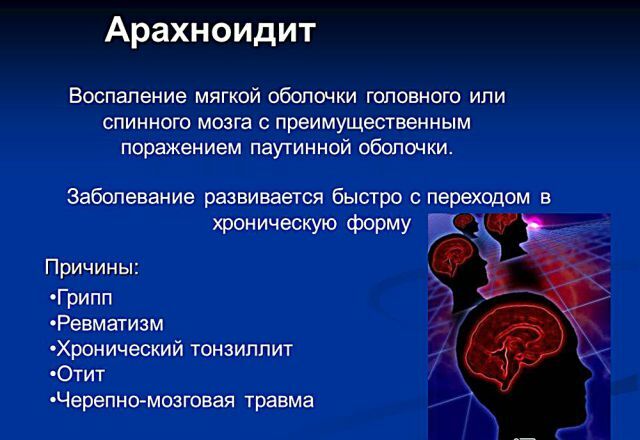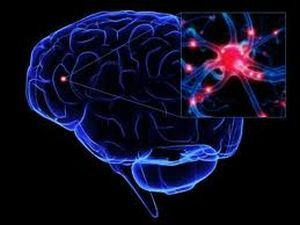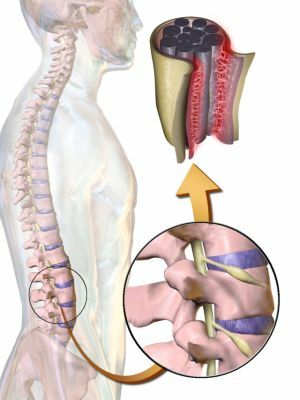 Arachnoiditis is an inflammatory process that occurs in the spider vein of the spinal cord or brain.
Arachnoiditis is an inflammatory process that occurs in the spider vein of the spinal cord or brain.
This is a rather serious disease, which often causes disability.
The emergence of this pathology can be associated with suffered head trauma, the presence of foci of chronic infection( tonsillitis, sinusitis);rheumatism;meningitis and other diseases of viral or infectious genesis, as well as exposure to chemicals.

Features of the clinical picture
The development of arachnoiditis is subacute, then becomes chronic. Cerebral arachnoiditis is characterized by a whole complex of symptoms, indicating a disruption in the functional capacity of the brain.
The subacute course of the disease occurs after infection or as an exacerbation of purulent diseases of the nose, ears. Perhaps the onset of remission.
Common symptoms include:
- headache , which becomes especially strong by morning: exacerbation occurs when the patient strains;
- vomiting - may be an adjunct to the above-described symptom;
- non-systemic dizziness ;
- memory corruption ;
- general malaise of ;
- mood swings ;
- insomnia .

Symptoms of arachnoiditis depends on the location of its localization:
- Convexal is characterized by epileptic seizures.
- Basal is defined by cerebral infringements, destructive processes of the function of nerves, which are localized in the cranial base.
- Optical-chiasmatic is accompanied by a deterioration of eyesight, eye fundus examination reveals hyperemia, blurred vision of the visual disk, expansion of arteries and veins. There is also acute thirst, frequent urination, intense sweating, rarely - deterioration of smell.
- Arachnoiditis, occurring at the location of the legs of the brain , is determined by the violation of the oculomotor nerves, signs of meningitis.

- If has inflammation of the bridge-cerebellar angle , the patient will experience tinnitus, headache, especially manifested in the nape of the neck, dizziness attacks, which rarely end with nausea and vomiting. With this form of illness, the gait is broken, becoming unsteady, uncertain. The patient can fall to the side where the lesion is localized, especially when standing on one leg. In the absence of treatment nystagmus develops, lesions of large nerves. Examination of the fundus allows to reveal the expansion of veins.
- For the disease occurring in a large cerebral cistern of the , there are sharp manifestations: an increase in body temperature;vomiting;pain of the cervical and occipital localization, increasing with the rotation of the head, trying to cough;defeat of cranial nerves;nystagmus;meningic symptoms.
- When arachnoiditis posterior cranial fossa pathological process affects the nerves of the skull. Also this form of ailment is accompanied by hypertension. If tumors have formed on the indicated area of the brain, a biopsy should be performed, but provided there are no stagnant processes.
- Spinal Arachnoiditis is an inflammatory process that occurs in the spinal cord. The disease occurs in acute, subacute and chronic form, although the exact time frame for them is not established. It is characterized by such manifestations as: numbness of the limbs;pain in the legs and lower back, resembling sciatica;muscle cramps and spasms;disruption of the pelvic organs.
Diagnostic methods
Initially, neurologist consultation is required. The diagnosis is determined after the patient undergoes a comprehensive examination, the primary goal of which is to exclude the presence of a brain tumor. The craniogram allows us to determine whether hypertension is a consequence of the cerebral form of arachnoiditis.
If there is a suspicion of convective arachnoiditis, an electroencephalogram is performed, with which the changes in biopotentials are visualized.
 Investigating the patient's cerebrospinal fluid, there is a probability of detecting lymphocytic pleocytosis - a change in cell elements that is characterized by an increase in protein concentration.
Investigating the patient's cerebrospinal fluid, there is a probability of detecting lymphocytic pleocytosis - a change in cell elements that is characterized by an increase in protein concentration.
Tomography is the main link in the diagnosis of arachnoiditis. Depending on the data obtained, establish the type of disease. It should be noted that the tomography is compulsory, because, in the presence of the disease, it will reveal the expansion of the subarachnoid space( as well as cisterns and ventricles), tumors, cysts.
Often doctors, referring the patient to the examination, have two options for diagnosis - arachnoiditis or cysticercosis. To determine more precisely, only research and clinical symptoms help.
Additionally, the following can be assigned:
- echoencephalography;
- scintigraphy;
- angiography.
Once an accurate diagnosis is established, it is necessary to identify the causes of the disease, which determines the selection of a future treatment program.
Diagnosis of spinal arachnoiditis in addition includes:
- clinical blood tests ;
- lumbar puncture , necessary for the analysis of cerebrospinal fluid, in which an increase in protein level is detected;
- myelography .
Provision of medical care to
If the source of the infection is the cause of the disease, the patient is prescribed antibiotics. A mandatory point of treatment for arachnoiditis is the use of antihistamines( Suprastin, Dimedrol), because they prevent the onset of edema. 
The patient is prescribed a long course of medicines that ensure the normalization of pressure inside the skull and the restoration of metabolism. One such medication is Pyrogenal, which promotes resorption of the focus of the inflammatory process. He is prescribed to patients in the form of intramuscular injections with a course of 30 doses.
Therapy also uses subcutaneous Lidase injections( 1 course - at least 15 doses), which improves vascular permeability, eliminates edema, improves joint condition, etc.
 If a patient is diagnosed with a concomitant increase in intracranial pressure, diuretics and drugs with anti-edematous properties( Furosemide, Lasix) are prescribed.
If a patient is diagnosed with a concomitant increase in intracranial pressure, diuretics and drugs with anti-edematous properties( Furosemide, Lasix) are prescribed.
Accompanying the disease with seizures predetermines the use of antiepileptic drugs( Lamotrigine, Primidon).
In addition, the metabolism is restored with the help of Aminalon, Pyracetam and the like.
Depending on the symptoms, additional drugs may be used, as well as substances that enhance biological processes.
Treatment by surgical methods is indicated if:
- did not improve the patient's condition after the treatment;
- intracranial pressure continues to increase;
- local symptoms increase;
- developed optico-chiasmal arachnoiditis.
Therapy of spinal arachnoiditis is reduced to taking painkillers, corticosteroids, muscle relaxants. To treat this form of the disease, electrostimulation of the spinal cord is used, which makes it possible to reduce pain.
Consequences of the disease and the prediction of
If the timely start of a full-fledged treatment, the patient's life is not threatened. The most dangerous is the development of arachnoiditis in the region of the posterior fossa of the skull, which is associated with occlusal hydrocephalus.
The patient may experience seizures that are close to epilepsy;hypertensive crises;visual impairment, right up to blindness.
Patients with arachnoiditis receive a disability, the extent of which depends on the severity of the consequences. The disease affects the  psychological background, as physiological difficulties affect the self-esteem, self-esteem. Irritability appears.
psychological background, as physiological difficulties affect the self-esteem, self-esteem. Irritability appears.
This significantly reduces the labor potential of a person who, after suffering a contraindicated to work in conditions related to height, vibration, noise, driving.
Acute spinal arachnoiditis is amenable to complete cure and recovery of nerve functions. Chronic form of the disease is less favorable, entails disability of the patient.



